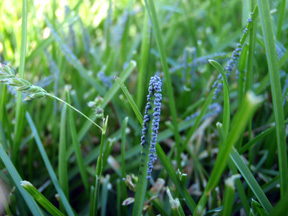Lawn slime
Editor’s note: This article is from the archives of the MSU Crop Advisory Team Alerts. Check the label of any pesticide referenced to ensure your use is included.
Every now and then I come across something I don’t see every day in a lawn. This week its slime mold. This is one of those diseases you see in the books, but that I only see every now and then in Michigan. Slime mold typically starts as a bright yellow, orange, purple or gray blob that causes some to ask, who puked in the lawn? It usually occurs during hot, wet weather and only lasts a couple weeks. As conditions dry out the slime mold changes and produces fruiting bodies full of spores that cover turfgrass leaves. Turf leaves may turn yellow during this period if they are completely covered by spores.
Slime molds are not infectious and are considered one of those turf diseases that is more cosmetic than anything. Fungicides are not necessary. Washing the mold from the leaves or light hand raking will help get rid of it quicker.



 Print
Print Email
Email


